What is a Bill of Lading (BOL)? Bill of Lading Definition
A bill of lading serves as a receipt for freight services. It is a legal document between a shipper and the carrier who transports their freight, which includes details of the type, quantity, and destination of the goods. A BOL document is the main contract between the Shipper, the Consignee, and the Carrier, which outlines the most important aspects of their business, contains the necessary shipment information and protects the shipment. Without an accurately filled bill of lading, freight shipment won’t be successfully transported or billed.
Who issues a bill of lading (BOL)?
The Carrier party is the only one who can issue the BOL to a Shipper of the goods and to the Consignee. The shipper is responsible for correctly describing all the essential shipment characteristics of the shipment. Sometimes, a bill of lading can be issued by the freight forwarder, however, not all forwarders are authorized to issue BOLs. The BOL is received by the shipper, a broker, or a freight forwarder.
What’s the purpose of a Bill of Lading Form?
1) It is a receipt for the goods shipped.
2) It evidences the contract between the carrier and shipper.
3) It serves as a document of title.
What Are the Bill of Lading Types?
There are different types of BOLs, but the two most important ones are a straight or generic bill of lading and an order bill of lading.
Straight bill of lading
A straight bill of lading (BOL) is a non-negotiable document, which means that freight services were paid in advance and do not require further payments.
Order bill of lading
An order BOL is one that is consigned to the order of a specific party and was not paid in advance. It’s an important designation in determining whether the BOL is negotiable. Also, an order BOL is capable of transferring title to the goods covered under it by its delivery or endorsement.
What’s in a bill of lading? BOL form information
Ultimately, a BOL is the most important document in the shipping industry. It provides all the information that the party which provides transportation services needs to process the freight shipment and invoice it correctly. A BOL form contains the following information:
- Shipper’s name and address
- Receiver’s/Consignee’s name and address
- Purchase Order numbers or special account numbers used for order tracking
- Special instructions
- Date of the shipment
- Number of shipment units
- Type of packaging
- Note if the shipment contains hazardous material
- Description of items
- The NMFC freight class
- The exact weight of the shipment
- The declared value of the goods
When a customer books a shipment with PLS PRO, our web-based transportation management system, the system automatically generates the BOL based on the shipment details entered during the quoting and booking process. Also, it is available online immediately, so you can easily download and share it.
Completing a BOL
Accuracy is crucial when filling out a bill of lading form. Even for experienced shippers, it can be a complicated and intricate task, especially if the freight has specific characteristics, or if the shipper is dealing with intermodal shipping. It’s best to trust your BOL to industry professionals like PLS Logistics that will assist you with correctly completing a BOL. Learn our ultimate guide on how to complete a bill of lading form!

